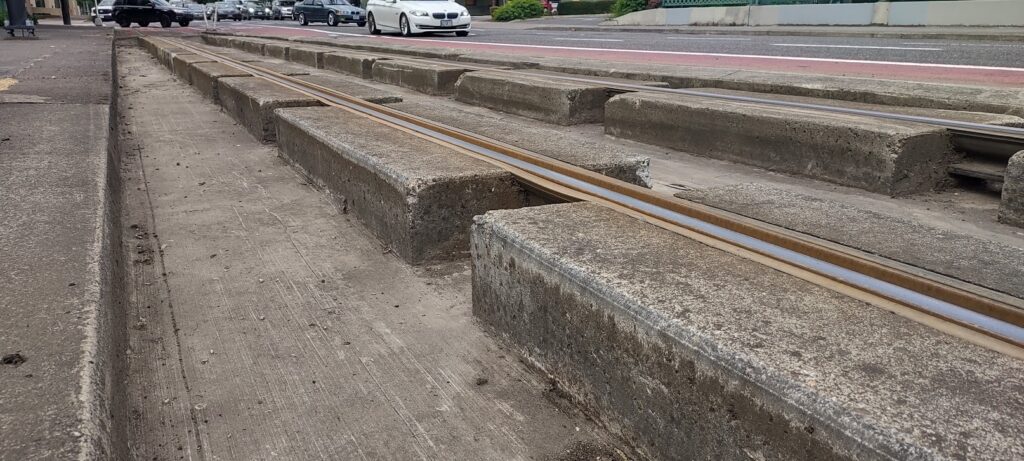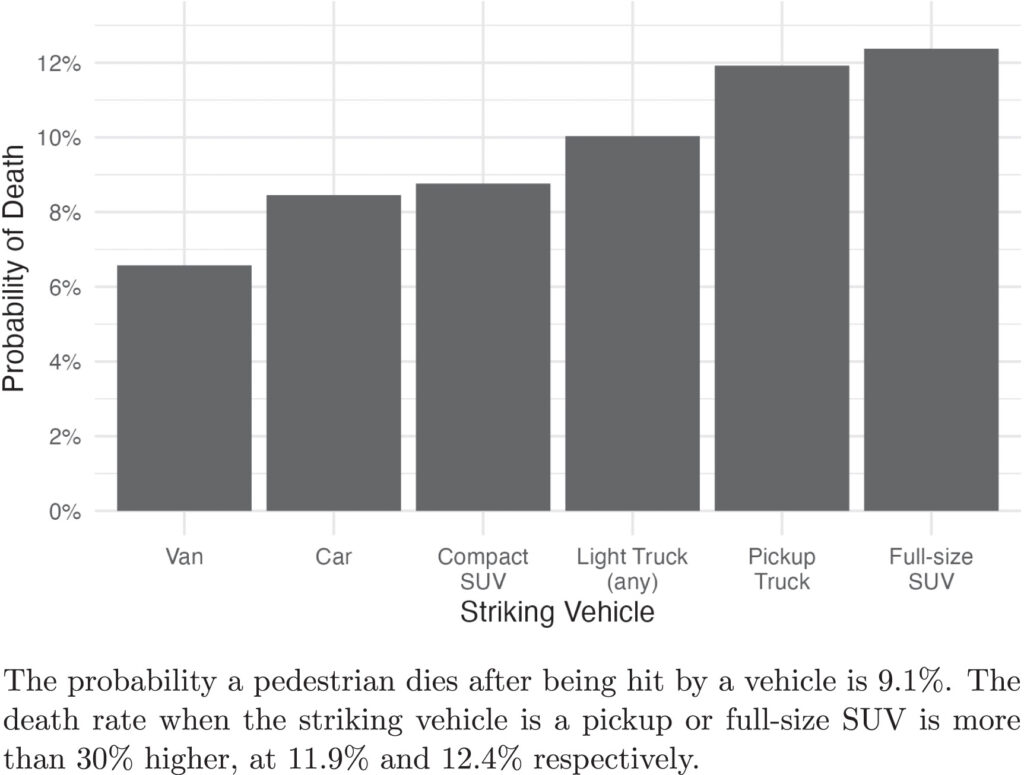What City Observatory this week
Robert Moses strikes again: One of the most infamous decisions of “The Power Broker” was to build the overpasses on the Long Island Expressway too low to allow city buses to use the roadway, cementing auto-dependency and blocking easy and economical transit access to many suburbs. And eight decades later, state highway departments are still doing essentially the same thing. Part of the likely $9 billion Interstate Bridge Replacement Project connecting Portland and Vancouver, Washington, is a short light rail extension across the Columbia River. (So far, so good). But the highway engineers are planning to build the transitway portion of the project with rails elevated on concrete blocks, so that that transitway cannot be used by buses. Using “direct fixation” rather than flush-mounted embedded rails is a bit cheaper, but forever makes the roadway impassible to buses (and impassible as an alternate route for emergency vehicles).
Instead, the highway engineers are planning to build an extra wide highway structure to theoretically allow for “bus on shoulder” service. Building the transitway (which runs on the lower level of a proposed double-decker bridge) so that it can’t also be used by buses, condemns all future bus service to mix with highway traffic (which requires climbing a steeper grade to the top level of the bridge, and merging with through car traffic). It’s a calculated decision by highway agencies to block better transit service, and create an excuse for a wider bridge (that can then be converted to more car lanes later). Somewhere, Robert Moses is smiling.
Must Read
Pushback on New York Times traffic safety story. The good news over the last month is that The New York Times gave prominent coverage to the dramatic surge in US road fatalities. It’s long overdue, and as road safety pundits regularly note, particularly given the the contrast between widespread publicity and quick action on even modest aviation safety issues (where there’s been great progress) and the steadily increasing death toll on the nation’s roads. The Times article clearly lays out the tragic statistics, but offers some questionable speculation about the underlying causes of the problem. In particular, the Times notes the increase in the number of deaths at night, and also correlates the surge in deaths with the advent of smart phones. As Stephen Coleman Kennedy writing at Greater Greater Washington argues, there are good reasons to question this speculation:
Focusing on whether someone is using their phone while walking, perhaps while wearing dark-colored outerwear at night, is an argument that rests on the concept that Americans are somehow both a) more technologically advanced than other countries and b) too stupid to use that technology safely. But looking at the data, peer countries with much lower pedestrian fatality rates use smartphones at similar rates.
He also points out that the cross-sectional evidence about crash deaths shows that some places (particularly sprawling, sunbelt metros) have much worse traffic safety records, which is a strong indicator that road design, rather than pedestrian behavior or smartphone distraction, is a key factor in our road safety problems.
Time for single-stair multi-family buildings. While most of the conversation about promoting affordable housing tends to focus on zoning, there’s a strong argument to be made that we need to re-think some key aspects of our building codes. One of the most widespread—and least examined—issues, is the general requirement that most multi-story buildings provide two separate routes of egress. This seemingly innocuous provision of the building code profoundly shapes what can be built, and requires nearly every new multi-story apartment building have long central corridors connecting two separate stairwells, usually at opposite ends of the building. This requirement effectively prohibits “dual aspect” apartments (where a living unit has rooms fronting on two or more sides of a building). If we allowed single stair buildings (which are common in most of the rest of the world), architects would have much more flexibility to design structures with a wide range of unit sizes, more creative layouts, and with less space dedicated to blank hallways. Stephen Smith makes a strong case for allowing single stair buildings for many 3- to 5-story apartment buildings.
Without the requirement for a second stair, buildings can be laid out in a fundamentally more efficient way. With less vertical circulation, the circulation core can simply be repeated a few different times, with apartments of different sizes arrayed off of each core, potentially stretching from the front of the building to the back. If planners redraw zoning envelopes to accommodate thinner buildings, more bedrooms can be packed in less square footage, offering more affordable and competitive family-sized designs.
Building codes are squarely in the control of state and local governments, and Smith has founded the Center for Building in North America to help do the thorough research that’s needed to show how with today’s technology, single-stair buildings can promote fire safety, and much greater housing affordability.
New Knowledge
The lethality of taller vehicles. For some time, it’s been obvious that the growing size of trucks and sport utility vehicles is strongly correlated with increased road death rates, especially for people on foot. A new study uses some very detailed crash data to validate the statistical connection between vehicle hood height and traffic fatalities. It concludes that increasing the height of the front of a car or truck by 10 centimeters—about four inches—increases the probability that someone will be killed in crash by more than 20 percent.
Justin Tyndall of the University of Hawaii assembled a unique database of vehicle-pedestrian crashes that looks at the height and weight of vehicles and other aspects of crashes, and shows that the larger the vehicle, the greater probability that a pedestrian will die.
Tyndall concludes that front-end height is the most significant variable affecting death rates. He concludes that height is more important the vehicle weight, and also that the changing composition of the vehicle fleet (more taller and heavier vehicles) likely means that pedestrian deaths may increase more in the future:
. . . high-front-end vehicle designs are particularly culpable for the higher pedestrian death rate attributable to large vehicles. A 10 cm increase in the front-end height of a vehicle increases the risk of pedestrian death by 22%. Conditional on multiple measures of vehicle size, front-end height displays the most significant effect. The shift towards electric vehicles is projected to make vehicles heavier still, as the batteries needed to power the vehicles add significant weight (Shaffer et al., 2021). If a strong relationship between pedestrian fatalities and vehicle weight exists, the number of fatalities attributable to vehicle size will likely continue to rise in the coming years. However, I find that once front-end height is controlled for, the impact of vehicle weight is small, suggesting the regulation of body design may be more important for pedestrian safety than the regulation of vehicle weight per se
Tyndall’s study should be read in combination with calculations from the Rocky Mountain Institute that show that fuel consumption and greenhouse gas emissions would be 30 percent lower today if personal vehicles were the same weight that they were a dozen years ago. The takeaway for policy is that the growing height and weight of cars, SUVs and light trucks is making the roads more dangerous, burning more fuel, and accelerating climate change.
Justin Tyndall, “The effect of front-end vehicle height on pedestrian death risk,” Economics of Transportation, Volume 37, 2024, 100342, ISSN 2212-0122,
https://doi.org/10.1016/j.ecotra.2024.100342.


